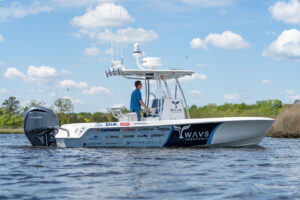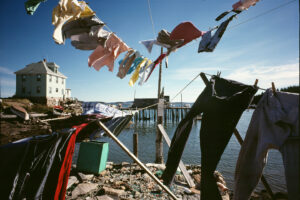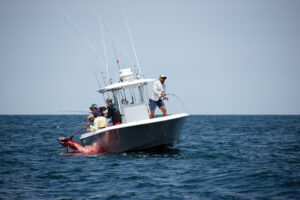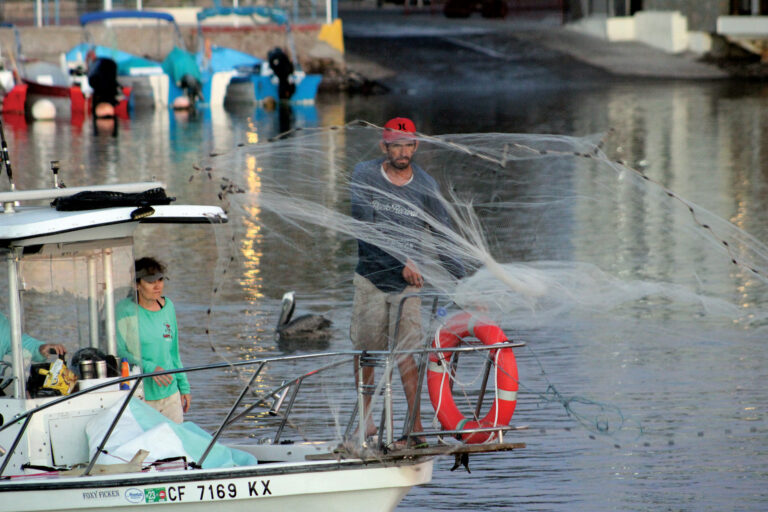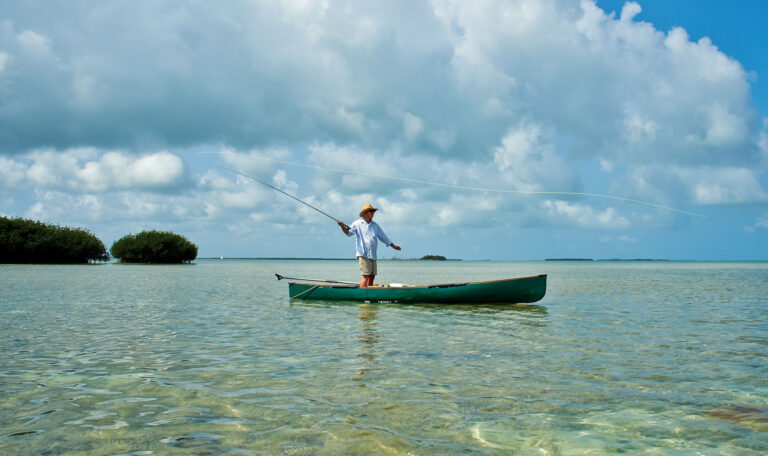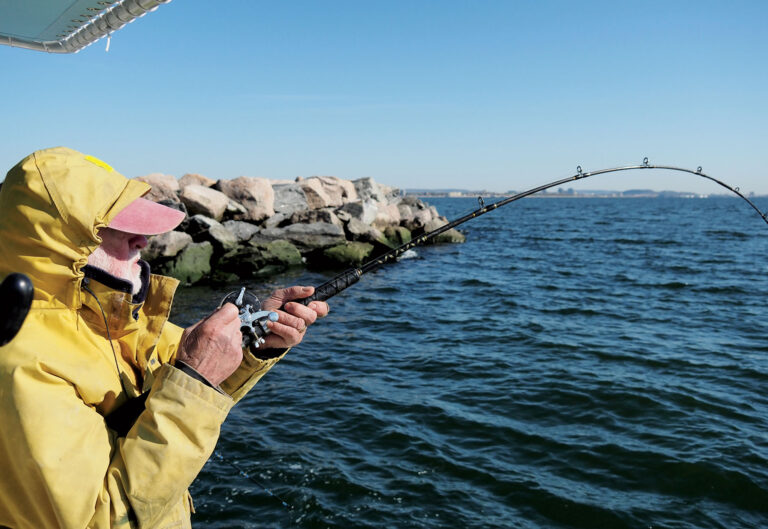 The bite, the head shakes, the jumps… seatrout put up a fight that leaves anglers thirsty for more.
The bite, the head shakes, the jumps… seatrout put up a fight that leaves anglers thirsty for more.My son’s cast flew skyward like a pop-fly and landed with a loud splash about 10 feet off the bow. The kerplop made me cringe and undoubtedly gave away our position to any fish within 50 yards. I was just about to suggest that he reel in and cast again when the slack line on the surface disappeared in a blink. His rod bent over hard, the tip dunked below the surface, and Max’s 7-year-old grip went full white-knuckle.
We were fishing a pocket of open water along the eastern edge of the Indian River off Oak Hill, Florida, with guide and longtime friend Capt. Scott MacCalla. It was Max’s first saltwater fishing trip, and you could call it a classic case of beginner’s luck — that was no dink seatrout on the end of his line. The fish burned line off the reel, shook its head and changed direction. Sitting on the forward casting platform, Max could only mumble a few words as he gritted his teeth and tried to lift the rod. “It’s too big!” he exclaimed.
I smiled and offered some fatherly encouragement: “You’re doing great.”
After a few tense moments of give-and-take, the trout was next to the boat. Its long silver body was dotted with dark spots, and a shimmery pot belly hung below its flanks. The yellow mouth displayed a set of fangs that’d make Dracula jealous. MacCalla netted the fish and placed it on a hand scale; it registered a hair shy of 7 pounds. Seven freaking pounds!
 The seatrout’s yellow mouth sports a set of fangs that would make Dracula proud.
The seatrout’s yellow mouth sports a set of fangs that would make Dracula proud.I’ve fished these waters since 2002, and this was the biggest trout I’d ever seen brought to the boat. As happy as I was for my son, in the back of my mind, I knew I was screwed. The seatrout bar had just been raised to a height I may never get close to again, let alone leap over.
Spotted seatrout, also referred to as speckled trout or spotted weakfish, are most abundant along the inshore waters of the Southeast and Gulf Coast, though they range north to Chesapeake Bay and the Delmarva Peninsula. Catching small, barely legal trout is easy. They’re aggressive and will hit just about anything, from a soft plastic to a topwater plug. You often catch the little ones by accident. When you locate a school of trout feeding next to a shell mound or along the edge of a marsh, you can hook up until your arms get tired. But big trout, the 30-inch gold standard variety that weigh 8 to 12-plus pounds, can take years to conquer. If catching a 15-inch trout is like winning $5 on a scratch-off ticket, a 30-incher is a Powerball jackpot.
“It’s a unicorn,” says Chris Bush, a 40-year-old Louisiana native who’s been obsessed with seatrout since he began fishing for them with his father as a boy.
In 2013, Bush, an active-duty Air Force officer, launched the website TheSpeckledTruth.com to foster a community of trophy-trout enthusiasts. “It’s all about the puzzle,” he says. “Every day these big trout give you a puzzle piece. You have to take that puzzle piece and try to insert it into the following day’s puzzle. The reward when you finally put the puzzle together is the tap, the head shake, all those things, but it’s that puzzle that really inspires. It forces you to challenge your angling mindset, your angling IQ.”
Talking to Bush is like talking to a musician who practices for hours a day and constantly tweaks his or her instrument. “I’d rather be known as a trout master than a full-blown colonel,” says Bush, whose rank is major.
 On the Gulf coast, wading for big trout is the preferred method.
On the Gulf coast, wading for big trout is the preferred method. Trout hit with a distinct thwap that almost always solicits a scream of joy from an angler. They destroy topwater plugs. They wolf down flies. When they are on the take, they are indiscriminate feeders that deliver a delicate, white fillet to those who harvest them. For these reasons, trout rank as one of the most popular inshore gamefish in the South. Just about any angler who’s caught a seatrout enjoys the tap and pull, but some folks take it to a heightened level.
Dr. Jay Wright, a 53-year-old pain management physician from Orlando, Florida, is perhaps the most afflicted trout addict I’ve ever met. Wright fishes with a fly rod and often goes out alone. “It’s hard to find someone patient enough to fish for these fish,” he says. “When I fish for big trout, I’ll see redfish and snook and all these other fish, and I won’t even throw to them. What ends up happening — and I’ve had it happen too many times to count — is if I see a red, throw to it and hook it, the fish takes off and will spook a giant trout that was laying there near it. I’m not going to jeopardize catching a big trout by hooking a redfish or snook.” That’s dedication. He has set three world records on fly, including a 9-pound seatrout on 2-pound tippet that he landed at Mosquito Lagoon on Florida’s east coast in 2018.
While younger trout may be attracted to the noise of a lure or a bait, the older, heavier females are incredibly wary; the fish’s array of senses conspires against anglers. They can sense slight movements in their lateral line. They have good vision, and they can hear very well, a function of their biological need to procreate. During the spawn, male seatrout croak to gather females.
Successful trout fishing is a mixture of stealth hunting and a perfect presentation that’s not too far, not too close and resembles exactly what’s on the menu, or as Bush says, putting the puzzle together. Juveniles feed on crustaceans and invertebrates, but as they grow, their diet consists solely of other fish. A large trout might eat every few days or once a week, but sometimes, even in ideal conditions, they just won’t take the bait.
 World-record holder Dr. Jay Wright says March is the best month for 10-pound trout.
World-record holder Dr. Jay Wright says March is the best month for 10-pound trout.“So many people that I talk to say, ‘I see these fish, but I can never get them to eat.’ That’s the hardest part,” Wright says. “You have to be very stealthy. Move slow, and if you are poling you have to creep so there’s no pressure wave. Just shuffling your feet to cast can put them off.”
Wright is so obsessed with trout that he plans his time off from work around the peak moon periods during spring. You won’t be able to get into his office when conditions point to giant trout. “Being a doctor and working a lot, I had to figure out the best times to fish,” he says. “I log every trout over 6 pounds. I log the date, time, water levels, clarity, what the tide was doing, water temp, moon phase, weather, barometric pressure, wind, any bait present, the fly I caught the fish on and other notes.”
Analyzing his data, Wright says March is the best month for fish weighing more than 10 pounds, with February finishing second and January coming in third. The best feeding times are around the new and full moons, and minor and major solunar periods. Wright prefers to sight-cast to the big sows (female seatrout), using baitfish patterns. This requires sun and clean water. But even when he finds a big trout in ideal conditions, the fish may not want to eat. “Honestly, I don’t think there’s a harder fish to catch on fly except maybe a permit,” he says.
Seatrout are a resilient fish, and populations have held strong for decades, but loss of seagrass and deep freezes can take a toll. More than 100,000 trout perished in Lower Laguna Madre during the Texas freeze in early 2021 that knocked out the power grid. Freshwater discharges in Florida, most of which come from agricultural land in the center of the state and are full of nutrients and herbicides, have decimated grass flats on both coasts. Trout depend on grasses for forage and protection. As water temperatures decline in the fall, the fish move to deeper waters. Come spring, they move back onto the flats.
 Large seatrout act like a very different fish compared to the juveniles.
Large seatrout act like a very different fish compared to the juveniles. Spotted seatrout reach sexual maturity at 1 to 2 years. The large fish are females and commonly live 9 or 10 years. Trout populations rebound quickly; after three deep freezes in Texas during the 1980s, the Coastal Fisheries Division said trout populations bounced back in three years.
While algae blooms, habitat loss and freezing weather take their toll on trout, recreational anglers impose the largest influence on the fishery. For generations, a good day of seatrout fishing meant catching your limit — 25 per person in Louisiana — but that measurement seems to be changing. “A good part of the degradation of the resource has been driven by our own egos,” Bush says, recounting his younger days, when he wanted to catch and keep as many trout as possible to “prove I was a really good fisherman.” But his mindset changed, from catching limits to catching quality.
To help instill the same virtue in others, Bush’s website includes a citation program, highlighting catches longer than 30 inches and sending stickers and certificates to the anglers. “I don’t have to be fulfilled catching a lot and keeping a lot. My fulfillment comes from keeping one fish,” he says. “Our saying isn’t catch and release everything; it’s take what you need and release the rest. It’s cool to watch anglers go through that maturity process and be a part of it.”


